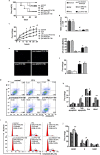Platelet factor 4 protects bone marrow mesenchymal stem cells from acute radiation injury
- PMID: 24922360
- PMCID: PMC4112396
- DOI: 10.1259/bjr.20140184
Platelet factor 4 protects bone marrow mesenchymal stem cells from acute radiation injury
Abstract
Objective: The aim of this study was to find a new radiation protector, platelet factor 4 (PF4) and to identify its effect on haemopoietic microenvironment in vitro and in vivo.
Methods: Radiation damage on bone marrow mesenchymal stem cells ex and in vitro was set up as models. Growth curve analysis, clonogenic survival assay, FACSCalibur™ (BD Immunocytometry Systems, San Jose, CA), 5-ethynyl-2'-deoxyuridine immunofluorescence staining and quantitative reverse transcription-polymerase chain reaction were employed to assess the characterization of bone marrow mesenchymal stem cells (BMSCs), proliferation, apoptosis, cell cycle and gene expression.
Results: A dose- and time-dependent enhancement of cell viability and survival was observed for PF4 treatment along with 500 cGy γ-radiation in vitro. The same phenomena were noted in vivo, including enhancement of adherence and proliferation ability while inhibition of cell apoptosis, which were associated with a short-term decrease in the G0/G1 ratio owing to S phase arrest. These were accompanied with enhanced Bcl-2 expression and p53/p21 loss.
Conclusion: These results uncover that PF4 might be a novel therapeutic approach, which could reduce DNA damage and increase survival of BMSCs, in part, by inhibiting p53/p21 axis and facilitating DNA damage repair.
Advances in knowledge: This study explores the feasibility of a new radioprotector and hence may be clinically important.
Figures





Similar articles
-
Gamma radiation induces senescence in human adult mesenchymal stem cells from bone marrow and periodontal ligaments.Int J Radiat Biol. 2012 May;88(5):393-404. doi: 10.3109/09553002.2012.666001. Epub 2012 Mar 20. Int J Radiat Biol. 2012. PMID: 22348537
-
Substance P stimulates the recovery of bone marrow after the irradiation.J Cell Physiol. 2011 May;226(5):1204-13. doi: 10.1002/jcp.22447. J Cell Physiol. 2011. PMID: 20945355
-
Effect of high-dose irradiation on human bone-marrow-derived mesenchymal stromal cells.Tissue Eng Part C Methods. 2015 Feb;21(2):112-22. doi: 10.1089/ten.TEC.2013.0766. Epub 2014 Jul 22. Tissue Eng Part C Methods. 2015. PMID: 24918644 Free PMC article.
-
[Mechanism of radiation induced premature senescence of bone marrow stromal cells: experiment with murine bone marrow stromal cells].Zhonghua Yi Xue Za Zhi. 2006 Dec 26;86(48):3431-4. Zhonghua Yi Xue Za Zhi. 2006. PMID: 17313858 Chinese.
-
p73alpha regulates the sensitivity of bone marrow mesenchymal stem cells to DNA damage agents.Toxicology. 2010 Mar 30;270(1):49-56. doi: 10.1016/j.tox.2010.01.011. Epub 2010 Jan 25. Toxicology. 2010. PMID: 20100536
Cited by
-
Xenografting of human umbilical mesenchymal stem cells from Wharton's jelly ameliorates mouse spinocerebellar ataxia type 1.Transl Neurodegener. 2019 Sep 5;8:29. doi: 10.1186/s40035-019-0166-8. eCollection 2019. Transl Neurodegener. 2019. PMID: 31508229 Free PMC article.
-
Cancer Stem Cells: Emergent Nature of Tumor Emergency.Front Genet. 2018 Nov 16;9:544. doi: 10.3389/fgene.2018.00544. eCollection 2018. Front Genet. 2018. PMID: 30505319 Free PMC article.
-
Transcription Factors STAT3 and MYC Are Key Players of Human Platelet Lysate-Induced Cell Proliferation.Int J Mol Sci. 2022 Dec 13;23(24):15782. doi: 10.3390/ijms232415782. Int J Mol Sci. 2022. PMID: 36555426 Free PMC article.
-
Regulatory roles of miR-22/Redd1-mediated mitochondrial ROS and cellular autophagy in ionizing radiation-induced BMSC injury.Cell Death Dis. 2019 Mar 7;10(3):227. doi: 10.1038/s41419-019-1373-z. Cell Death Dis. 2019. PMID: 30846680 Free PMC article.
-
The combination of three-dimensional and rotary cell culture system promotes the proliferation and maintains the differentiation potential of rat BMSCs.Sci Rep. 2017 Mar 15;7(1):192. doi: 10.1038/s41598-017-00087-x. Sci Rep. 2017. PMID: 28298644 Free PMC article.
References
-
- Nicolay NH, Sommer E, Lopez R, Wirkner U, Trinh T, Sisombath S, et al. . Mesenchymal stem cells retain their defining stem cell characteristics after exposure to ionizing radiation. Int J Radiat Oncol Biol Phys 2013; 87: 1171–8. - PubMed
Publication types
MeSH terms
Substances
LinkOut - more resources
Full Text Sources
Other Literature Sources
Research Materials
Miscellaneous

